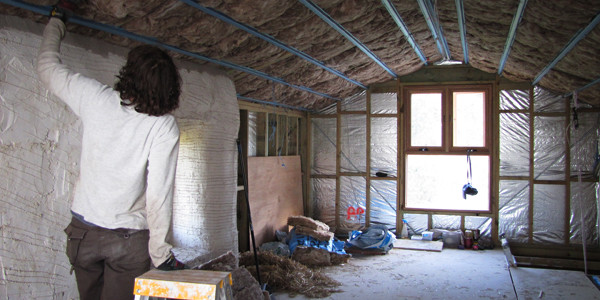Winter is usually a time for garages to hibernate, as they seem to get a lot of use during the warm seasons. Although it might be cold outside, there’s no reason to abandon your garage just yet. Choosing the suitable heating options for your garage will make it cozy and toasty in no time. In the winter or whenever it’s cold outside, these heating solutions might be helpful if you wish to work in your garage more.
However, car repairs or building furniture may become challenging and uncomfortable when it’s freezing inside your garage. Your equipment will also be frozen, and paints and glues won’t adhere correctly. Keep reading if you enjoy doing DIY projects and utilize your garage workshop throughout the year, not only during the warmer months. Here is some of our best advice for keeping the garage warm enough to be a comfortable workspace no matter the weather.
You must first insulate and weatherize
If your garage lacks adequate insulation and weather stripping, you could easily see your energy costs double or triple during the heating season. Keeping your garage energy efficient is the same as keeping your home energy efficient. The energy lost through drafty windows or transmitted through uninsulated walls is the energy you pay for, so make the same efforts to keep your house energy efficient. It is estimated that the Department of Energy estimates you can save up to 20 percent on energy costs by adding insulation.
Here are a few things to keep in mind:
- Windows: If the garage is heated in winter, make sure the windows are as well insulated as the windows in your home. Glass that is double- or triple-paned and filled with inert gas is the most energy-efficient.
- A garage door with polyurethane foam inside is the most energy-efficient option. Steel, aluminum, or fiberglass doors with this material have the best R-value (the resistance to temperature change). Polystyrene foam with a thickness of 1 3/8-inch has a thermal conductivity of 6.5, while a door made from plain wood has an R-value of about 4 to 5, while polyurethane foam has an R-value of up to 20. Experts recommend that garages with heating should have overhead doors with R-values of at least 10 to 12.
- Ensure the weather stripping along the bottom of the leading garage door is in good condition due to drafts being the primary source of energy loss. Also, make sure that passage doors and windows are adequately sealed.
- Insulate external walls: A garage that will be heated and used in the winter deserves to be insulated with the same fiberglass batts used in your house.
- It is best to finish your ceiling: Many garages have rafters and trusses hanging from the top. The spaces between the rafters and trusses should be insulated, and the roof should be finished with a wallboard to minimize heat loss.
Gas and liquid fuel heaters are available
Space heaters powered by liquid fuels, such as kerosene, liquid propane, or natural gas, are suitable for a garage. There are two main types:
- A freestanding heater that runs on kerosene or propane is a good option for heating small areas, but it’s only valid for heating small spaces. A kerosene or propane space heater can increase the temperature inside an insulated garage, but it can also release moisture and carbon monoxide into the air. Freestanding liquid fuel heaters ought to be used with caution in enclosed spaces – safety experts suggest against this.
- Direct-vent space heaters are an excellent option for garage heating, especially if you already have a propane or natural gas line running to your household appliances like your furnace, stove, or fireplace. A direct vent garage heater exchanges combustion air and exhaust fumes through a pipe installed in the wall, so carbon monoxide is not a concern. You should choose a model with maximum efficiency if you plan to use the heater frequently. Even though direct-vent heater providers provide instructions for installing the units yourself, it is best to hire a professional to install the gas line. Direct-vent space heaters may be the best choice in a cold climate where the garage has to be heated frequently or at a constant temperature above freezing.
Wood Stoves
It is possible to heat the garage effectively with a wood stove under some circumstances, particularly if you have a steady supply of inexpensive wood available. Wood stoves, however, have some drawbacks.
It will be necessary to give the stove adequate clearance from combustible materials before installing it. Additionally, every wood stove must be connected to a chimney. Using a wood stove is not a good option if you need short-term, quick heat since it takes a long time to heat up and will continue to work even after you stop feeding it fuel. A wood stove may be ideal for projects in the garage that last for several hours. A wood stove would be a perfect solution to using scrap lumber in a woodworker’s case.
Electric Heaters
There are a variety of electric heaters that can be used to heat a garage, from small 120-volt plug-in models to large 240-volt radiant heaters or even permanent baseboard heaters. It is a convenience of electric heaters that makes them so popular. You don’t have to hook up the heater to the furnace or boiler, and there is no chimney or vent pipe to install. Electric heaters are quiet, clean, and discreet.
The cost to purchase and install electric heaters is generally low, but the cost of operating them constantly can become relatively high in freezing climates. The best way to keep your garage warm with electric heat in a cold environment is to insulate and weatherproof it fully. Electric heaters are ideal for moderate temperatures where subfreezing temperatures are rare.
Types of electric space heaters for garage
Read More: What Is Hyperbaric Oxygen Therapy? And What Are The Hyperbaric Oxygen Therapy Benefits?
The convection heater
A convection heater is a heating device that uses convection currents to distribute heat throughout a room or space. Unlike traditional radiant heaters, which rely on infrared radiation to warm a specific area, convection heaters work by circulating air over a heating element and then distributing that warm air throughout the room. This makes convection heaters highly efficient and effective in heating a space, as they can evenly distribute heat and reduce hot and cold spots. They come in various sizes and designs, from small personal heaters to large wall-mounted units, making them a versatile option for any heating needs. Additionally, convection heaters are often more energy-efficient than other heaters, making them a great choice for anyone looking to reduce their energy costs.
Warm air is circulated in a room by convection heaters, which use the natural effects of warm air rising and cool air falling to warm the air. Various convection heaters, including electric baseboard heaters and oil-filled portable plug-in radiators, are available. Heaters with automatic shut-off features are relatively safe, especially when equipped with a tip-over mechanism. Ceramic heaters fall into the category of convection heaters.
Radiant Heaters
Radiant heaters produce heat around them, including people, but they do not specifically heat the air. The problem with this is that it is a good option if you want heat quickly, but it is also quite risky since people and pets can burn, and it can cause a fire if operated too close to flammable materials.
Combination Heaters
In combination heaters, a fan distributes the heat produced by radiant coils, combining the virtues of radiant and convection heating.
FAQs
- How can a garage be heated most efficiently?
Despite its high cost, in-surface radiant heating is one of the most efficient methods of heating garages because it heats the surface rather than the air around it.
- Should you heat your garage?
If you park your vehicle in a heated garage, you don’t need to warm it up before getting in, saving you fuel. Warm garages also extend the battery life and improve your vehicle’s performance. Furthermore, if you need to jump your car in the winter, you will be much happier doing so in a heated garage.
- How do you heat your dog’s garage in the winter?
Keeping your dog warm in the garage is as simple as ensuring it is adequately insulated.








